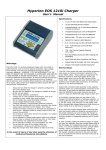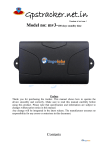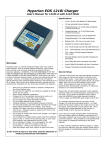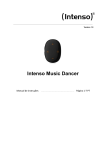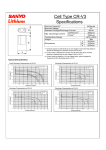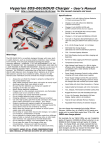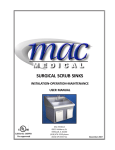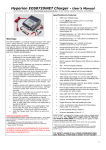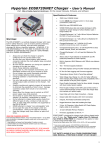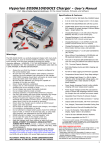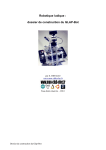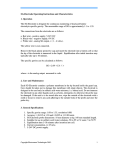Download EOS 7i Charger
Transcript
EOS 7i Charger Speed 5S 25N User’s Manual rev 1.2 Specifications: Fully Programmable, Versatile Fast Charge-Discharge with Cycling • 2 Line LCD for charge monitor and post data display • Charge/Discharge 1-25 cell NiCad/Ni-MH Batteries • 2-12v Lead Acid Batteries • Charge/Discharge 1 to 5 cells Lithium Polymer Batteries • PCM Device Safe - 23V clamp on open circuit event in lithium mode • 100-7000mA Charge Current (120 Watt Maximum) • 100-3000mA Discharge Current (20 Watt Maximum) • 10 User-definable Memory Positions • User Definable Settings: *Battery Pack Type, Number of Cells, Capacity *Charge/Discharge Current in 100mA increments *Delta Peak sensitivity for NiCad/Ni-MH *Temperature detection for NiCad/Ni-MH • 12.0~15.0V DC input voltage. • Audible Function Alarm • Integral Cooling Fan Warnings: General Setup: The EOS 7i is a carefully-designed charger with many built-in safety features, such as reverse polarity protection, input voltage error warning, and cell-count mismatch warnings for lithium chemistry batteries. HOWEVER, IT IS THE RESPOSIBILITY OF THE USER TO INSURE THAT THE CHARGER IS CONFIGURED AND USED IN A SAFE MANNER IN PROPER ENVIRONMENT. The EOS 7i comes with male 4mm Bullet connectors (also known as ‘banana connectors’) attached to the power INPUT cables. These cables are appropriate for attaching directly to most high-quality AC-DC 12V power supply units, such as the BK Precision (USA) model 1692. Also included are large Terminal Clips with matching 4mm female bullet connectors, for attaching directly to 12V leadacid batteries. • • • • • • • • • • • • • • • Always be sure that the charger is properly configured for the correct battery type (and voltage for lithium batteries). Be sure that the batteries you charge are capable of charge at the rate you select. Never charge batteries unattended. Charge only in a fire-resistant environment, such as on concrete or brick, rather than wood surfaces. Do not charge near easily flammable materials. Do not charge batteries inside a model. Charging outdoors is recommended whenever practical Use only high-quality gold 4mm bullet connectors for charge output cable connection to the charger. See “setup”. Insulate all Output connectors to eliminate the possibility of short circuit. Damage caused by output short circuit is not covered by warranty. Do not drop or cause other shock to the charger, nor subject it to moisture or water Do not attempt to charge battery packs made from different types of cells, a mixture of old and new cells, or cells made with chemistry not supported by the EOS 7i Do not attempt to charge “non-rechargeable” dry cells. Do not open the case of the charger under any circumstances. Doing so will void the warranty. Keep the charger away from children or pets at all times. In the event of injury of any kind, seek the attention of medical professionals immediately. Output side connector/cable assembly is also supplied. Carefully solder your preferred battery connector to the free ends. If you make up additional output cables, note that MINIMUM inner cable diameter should be 2.5mm (14ga) and MAXIMUM cable length is 20cm (8”). It is critically important that you use either a fully charged 12V lead-acid battery of adequate capacity - or a high quality AC-DC power supply in the range of 12V to 15V DC output, with minimum current rating of 12A. When charging high voltage batteries at high current an output rating of up to 20A may be required. If you have any trouble charging after confirming that input and output cables are properly connected and of the proper materials, be sure to check the charger on an automotive battery. Many problems are associated with poor quality or inadequate switching AC-DC power supplies. If, after carefully reading the following pages on usage, you have any difficulty using the charger please refer to the final pages for troubleshooting guide and warranty terms. It is well to carefully check your charger before making a return, as problems in setup, cabling, or power supply are much more common than defects in the charger. Chargers returned to Hyperion and found not defective will only be returned to the user at the user’s expense. Charging/Discharging: The “Auto” modes for NiCd and NiMh battery types are preferred whenever you have a battery pack made from quality cells and in good condition and balance. The EOS 7i charges NiCd and NiMH in Auto Mode based on an intelligent algorithm which maximizes performance and minimizes charge time. These two pre-configured memory positions cannot be edited: A1 - NiCd Automatic A2- NiMH Automatic Ten additional memory positions - M0 to M9 - allow you to choose parameters for charging or discharging, such as battery type (NiMH, NiCd, Lithium, Lead-Acid), battery capacity, discharge rate, cutoff voltage or temperature, and more. After connecting the charger to a suitable power source, the LCD monitor will show the configuration used in the previous session. Please be absolutely sure that you know the type of lithium battery you are charging, the capacity in mAh, and the number of cells wired in series before you start charging! Pb 1 cell 2.0V Number of Cells in Lead Acid Battery 2 cells 3 cells 4 cells 5 cells 4.0V 6.0V 8.0V 10.0V 6 cells 12.0V For NiCd and NiMH, choose the Number of Cells in the battery pack. If you know the nominal rated voltage of the pack, but not the number of cells, divide voltage by 1.2 to get cell count: Example: 9.6V / 1.2 = 8 , so there are 8 cells in the pack ----------- Capacity Selection -------------After you have selected the correct voltage/cell count using the UP/DOWN buttons, press SETUP to move to CAPACITY selection. For Pb Lead-Acid batteries, capacity is in Ah (Amp Hours). Now let’s use the input buttons to change the battery type. Press: ENTER: Memory Position Blinks (M7 above) UP/DOWN: Scroll through memory positions SETUP: Edit the parameters for a position After SETUP is pressed, you will see the text for battery type blinking (“LiPo” or “NiMH” for example). Press UP/DOWN buttons to scroll through battery type selections. Press SETUP again to set the battery type currently displayed, and the cursor then moves to Voltage selection. For lithium polymer, voltages are listed as number of cells in series, or “S” as in the table below. Number of Cells Wired in Series (S) 1S 2S 3S 4S 5S 3.7V 7.4V 11.1V 14.8V 18.5V For NiCd, NiMH, and Lithium cells, this is given in mAh. Selection is in increments of 100mAh. If your battery does not fall on an exact division of 100 - for example battery is rated 670mAh - you should choose the next closest setting. In our example, 700mAh would be appropriate. Consult the documentation provided with your battery to determine the correct setting. It is very important to get this right, as the charger uses the capacity setting to determine nominal charge rate (amperage) and safety termination. Incorrect settings could damage the battery, and could even cause an accident. ----------- Additional Settings -------------Once you have completed the settings for Battery Type, advanced users may choose to alter other settings related to charge or discharge of the battery. Use the DOWN button to follow the next settings for NiCd and NiMh batteries. Use SETUP to cycle through the options on each page, as before. TROUBLESHOOTING: WARRANTY: (1) Check again that the battery you are trying to charge and the settings on the EOS 7i match. Battery type, such as NiMH or Lithium), battery capacity, and number of cells (charge voltage) must all be correct. The HYPERION EOS 7i Charger is guaranteed to be free from defects in materials and workmanship for a period of one calendar year from date of purchase. (2) Check that the input cable and output cables: *Have proper connectors in good condition *Are not frayed, worn, cut, or damaged *Are the proper gauge (2.5mm, 14ga) *Are proper length - 20cm (8”) on output side (3) Attach the EOS 7i input connectors to a 12V automotive battery that is in good condition. Wiggle the Terminal clips into the battery posts to insure that you have a good connection. Many charger problems are due to poor quality or inadequate switching AC-DC power supplies, so this test is necessary to eliminate those from the list of suspects. (4) Try another model battery for charging. If your RC battery is in poor condition, over discharged, or in some other way defective the charger may correctly refuse to charge it based on safety algorithms. (5) Try another RC battery type. For example switch to a NiMH battery if you are failing to charge Lithium types. Success with one type but failure with another indicates that the charger is working properly. The failing battery type is almost certainly in poor condition, then, or you have improperly set the charger for it. (6) Contact your dealer with full details and description of the problem, including the type of input power source, RC battery type and cell count, and history of the charger - that is, has the charger been working properly before, or failing from new condition? Deleted #7 Damage due physical shock (dropping on the floor, etc), inappropriate power supply (car battery charger!), water, moisture, or humidity are specifically NOT covered by warranty. Your selling dealer is your first point of contact for warranty issues. See (6) page left. Return postage costs are the responsibility of the user in all cases. Returned units will be examined by the Hyperion dealer’s tech department within 2 weeks of arrival, maximum. In the event that defects in components are found, a replacement charger will be sent to the user without charge. REPAIR DUE TO NON-WARRANTY ISSUES: Due to the nature of the miniature electronics employed, and high cost of hand labor, it is not economically feasible to repair EOS chargers in most cases. Instead, we offer a blanket exchange policy at 50% of the US$ suggested retail price of $140.00, equal to $70.00 US. IN the event that your charger is damaged and warranty will not apply, please send the EOS 7i to your selling dealer for exchange under this program. TROUBLESHOOTING: WARRANTY: (1) Check again that the battery you are trying to charge and the settings on the EOS 7i match. Battery type, such as NiMH or Lithium), battery capacity, and number of cells (charge voltage) must all be correct. The HYPERION EOS 7i Charger is guaranteed to be free from defects in materials and workmanship for a period of one calendar year from date of purchase. (2) Check that the input cable and output cables: *Have proper connectors in good condition *Are not frayed, worn, cut, or damaged *Are the proper gauge (2.5mm, 14ga) *Are proper length - 20cm (8”) on output side (3) Attach the EOS 7i input connectors to a 12V automotive battery that is in good condition. Wiggle the Terminal clips into the battery posts to insure that you have a good connection. Many charger problems are due to poor quality or inadequate switching AC-DC power supplies, so this test is necessary to eliminate those from the list of suspects. (4) Try another model battery for charging. If your RC battery is in poor condition, over discharged, or in some other way defective the charger may correctly refuse to charge it based on safety algorithms. (5) Try another RC battery type. For example switch to a NiMH battery if you are failing to charge Lithium types. Success with one type but failure with another indicates that the charger is working properly. The failing battery type is almost certainly in poor condition, then, or you have improperly set the charger for it. (6) Contact your dealer with full details and description of the problem, including the type of input power source, RC battery type and cell count, and history of the charger - that is, has the charger been working properly before, or failing from new condition? Deleted #7 Damage due physical shock (dropping on the floor, etc), inappropriate power supply (car battery charger!), water, moisture, or humidity are specifically NOT covered by warranty. Your selling dealer is your first point of contact for warranty issues. See (6) page left. Return postage costs are the responsibility of the user in all cases. Returned units will be examined by the Hyperion dealer’s tech department within 2 weeks of arrival, maximum. In the event that defects in components are found, a replacement charger will be sent to the user without charge. REPAIR DUE TO NON-WARRANTY ISSUES: Due to the nature of the miniature electronics employed, and high cost of hand labor, it is not economically feasible to repair EOS chargers in most cases. Instead, we offer a blanket exchange policy at 50% of the US$ suggested retail price of $140.00, equal to $70.00 US. IN the event that your charger is damaged and warranty will not apply, please send the EOS 7i to your selling dealer for exchange under this program.





